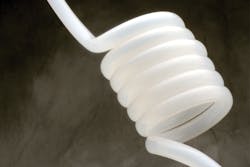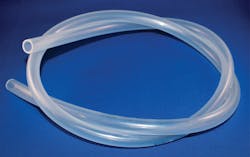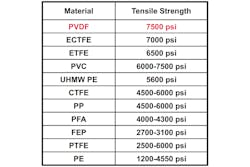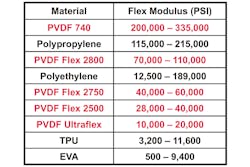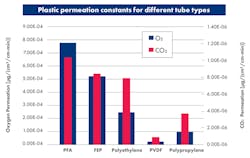PVDF copolymers for flexible fluid handling components
Polyvinylidene fluoride (PVDF) is a fluoropolymer with robust characteristics for the food and beverage industry. As a cost-effective, high-performance polymer, PVDF is often utilized where metal tubing and commodity plastics have limited lifespans. When concern exists related to failures associated with brittleness, chemical resistance or abrasion resistance, the inherent properties of the PVDF polymer offer upgraded solution options for manufacturing facilities looking to maximize productivity for fluid handling components.
Flexible tubing
PVDF copolymers are flexible in nature, lending themselves to the manufacture of tubing and other fluid handling components. High in purity with no additives or stabilizers, PVDF tubing serves the food and beverage industry in areas including beverage dispensers, where PVDF is a premier choice for long-lasting systems.
PVDF is a nonstick material that offers a multitude of benefits. First, bacterial and fungal growth is diminished because the slippery surface is not a welcoming home for microbes to colonize.1 Fluid handling systems that utilize PVDF provide an inhospitable home for biofilm, fungi and other pathogens. The low coefficient of friction makes PVDF a material that has a naturally nonstick surface. This minimizes the absorption of taste and flavor and combats staining. Machines with centralized dispensers that serve alternating flavors benefit greatly from this characteristic since contaminating drink quality is an important issue for other plastics.
Cleaning chemicals like bleach and acids have little to no effect on taste when used with PVDF components. PVDF provides solutions for critical applications that call for flexible tubing that can withstand aggressive cleaning agents while also controlling permeation and flavor absorption.
Mechanical properties
PVDF has excellent mechanical property retention up to 302°F (150°C). The strongest commercial fluoropolymer on the market, PVDF may be utilized in self-standing components such as piping systems, pumps, valves and any other melt-processable components. Also, testing has shown that sterilization with saturated steam up to 127°C has no significant effect on PVDF piping systems.2 These same systems have a UL RTI rating of 150°C. Table 1 shows the mechanical strength of PVDF.
Chemical and permeation resistance
PVDF is a fluoropolymer that has excellent chemical resistance ranging from <1 to 13.5 pH, lending itself to use in contact with acids such as nitric, phosphoric, citric and peracetic as well as with chlorine, bleach, caustic soda and solvents. The chemical resistance of PVDF has been studied for many years and can be found in public literature. Furthermore, its polarity and crystallinity make it one of the least permeable materials compared to many other plastics, as in Figure 2.5Purity
PVDF components used in fluid handling have no additives, thus they are used for high purity in many industries that require low levels of extractables. Studies have shown that certain PVDF grades will have lower extractable levels than metals commonly used in the market, allowing pure fluids to be processed throughout the plant without fear of contamination. It has been noted that using a pure PVDF material minimizes the risk of taste and flavor absorption.
Flame and smoke properties
The recent increase in the occurrence of food processing plant fires has been a driving force in searching for materials that are more resistant to flame and smoke propagation.6 PVDF, with its history of use in low flame and smoke applications such as wire and cable, has proven itself as a top material for limiting fire damage. With limit oxygen index values ranging from 40 to 100, PVDF contributes little heat, greatly reducing the potential of flame spread. Furthermore, PVDF self-extinguishes once the direct flame source is removed.
Multilayer tubing
To maintain excellent chemical resistance, low taste contamination and high purity while utilizing other polymer structures in a tube construction, some PVDF grades are functionalized to tie to different polymers like polyolefins, nylons and urethanes. PVDF can even bond directly to certain urethanes without a tie layer. A two- or three-layer structure can help achieve an overall balance of high-performance properties as well as a cost-effective approach via multilayer extrusion. Not everything likes to stick to fluoropolymers, so experts in the field can provide advice on material selections.
Ease of processing
PVDF is the easiest and most benign of the fluoropolymers to process. Because of its lower melting point, PVDF has the widest processing window and can be extruded or injection-molded using only standard polyolefin equipment.
Additional applications and industries
Although PVDF tubing is used in the food and beverage market, its utility is also appreciated across other industries because of the attributes described in this article. The chemical processing industry utilizes PVDF components for properties such as chemical resistance, high temperature stability and low permeation. The pharmaceutical, biotechnology and semiconductor industries use PVDF because of its high purity and cleanability. The oil and gas market space uses PVDF tubing for chemical injection while the automotive industry makes flexible fuel hoses for truck and passenger automobiles. In other industries such as wastewater treatment, PVDF properties like chemical resistance and UV stability are of particular interest. Flexible tubing, hoses and piping systems that use PVDF as the material of construction make it a versatile material for a variety of fluid handling applications.
Certifications and listings
PVDF resins are compliant with the following regulatory requirements in the food and beverage industries.
- National Sanitation Foundation (NSF) — NSF 51 and NSF 61
- Food & Drug Administration (FDA) — 177.2510 & 177.2600 Repeated contact with Food
- 3A Sanitary Standards (3-A SSI)
- UL RTI — 150C Continuous Use rating
- Certified Kosher by the Chicago Rabbinical Council
References
- Kozicki, M. 2012. Cleanrooms: Facilities and Practices. Springer Science & Business Media, p.180. https://books.google.com/booksid=GGsyBwAAQBAJ&pg=PA180&lpg=PA180&dq=pvdf+coefficient+of+friction+bacteria&source=bl&ots=rsoQYayjwQ&sig=pgIGPw0WTRG78VYJ5gKITjlEX0&hl=en&sa=X&ved=0ahUKEwi39vSQ5unZAhVImJQKHfZHDGEQ6AEIKTAA#v=onepage&q=pvdf%20coefficient%20of%20friction%20bacteria&f=false.
- Gruen, H., Burkhart, M., O’Brien, G. 2001. Steam Sterilization of PVDF Piping Systems in PW and WFI for the Pharmaceutical and Biotechnology Applications. 2001. Ultrapure Water. October 2001.
- Hanselka, R., Williams, R., Bukay, M. 1987. Materials of Construction for Water Systems Part 1: Physical and Chemical Properties of Plastics. Ultrapure Water. July August 1987. Pp 46-50.
- UL Prospector Materials Database
- Carr, G. 2000. The Effect of Plastic Tubing Type on Oxygen and Resistivity Measurements in High Purity Water. Ultrapure Water. December 2000. Pp. 17-19
- Jackson, M. 2017. Haltom City Firefighter Hospitalized Due to Overwhelming Smell at Food Plant. https://www.nbcdfw.com/news/local/Haltom-City-Firefighter-Hospitalized-Due-to-Ammonia-Smell-at-Food-Plant-410380535.html
Averie Palovcak graduated with Bachelor of Science and Master of Science degrees in biomedical engineering from Drexel University. She works for Arkema as an applications engineer for the Technical Polymers Division. Palovcak can be reached at [email protected].
Jason Pomante graduated from Lafayette College in 2002 with a Bachelor of Science in chemical engineering and MBA from Saint Joseph’s University in 2010. He has worked at Arkema for 15 years and is currently the North American market manager in the Technical Polymers Division. Pomante can be reached at [email protected].
